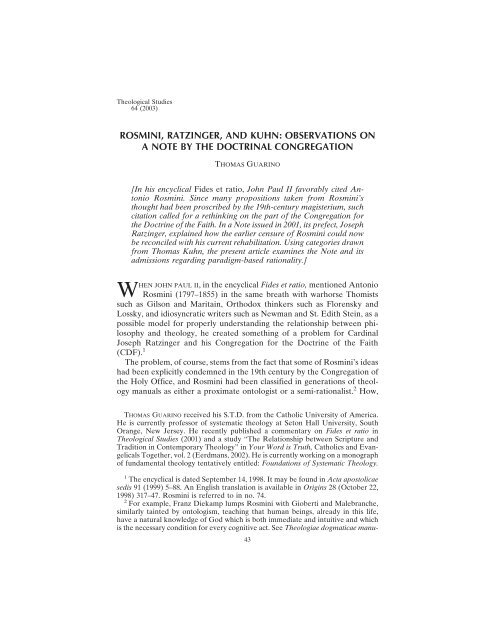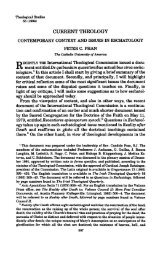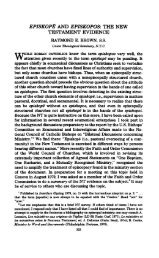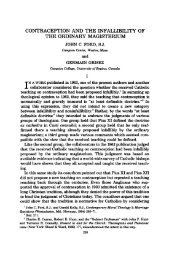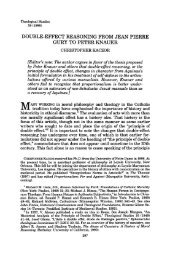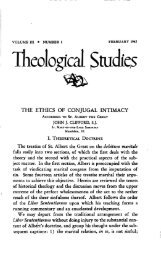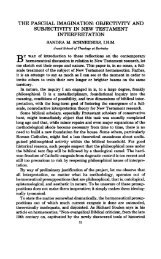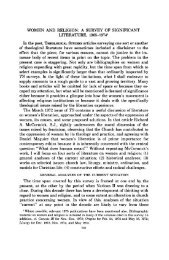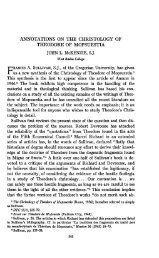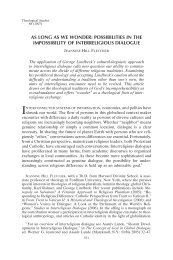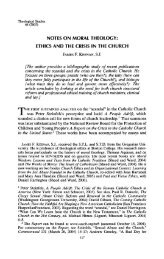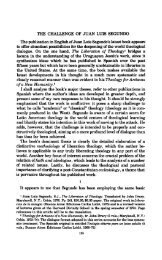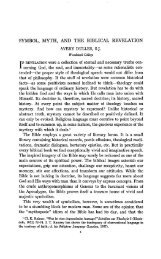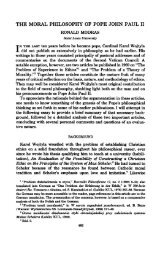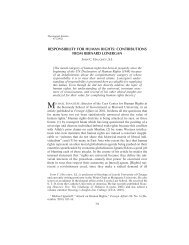rosmini, ratzinger, and kuhn - Theological Studies
rosmini, ratzinger, and kuhn - Theological Studies
rosmini, ratzinger, and kuhn - Theological Studies
You also want an ePaper? Increase the reach of your titles
YUMPU automatically turns print PDFs into web optimized ePapers that Google loves.
<strong>Theological</strong> <strong>Studies</strong><br />
64 (2003)<br />
ROSMINI, RATZINGER, AND KUHN: OBSERVATIONS ON<br />
A NOTE BY THE DOCTRINAL CONGREGATION<br />
THOMAS GUARINO<br />
[In his encyclical Fides et ratio, John Paul II favorably cited Antonio<br />
Rosmini. Since many propositions taken from Rosmini’s<br />
thought had been proscribed by the 19th-century magisterium, such<br />
citation called for a rethinking on the part of the Congregation for<br />
the Doctrine of the Faith. In a Note issued in 2001, its prefect, Joseph<br />
Ratzinger, explained how the earlier censure of Rosmini could now<br />
be reconciled with his current rehabilitation. Using categories drawn<br />
from Thomas Kuhn, the present article examines the Note <strong>and</strong> its<br />
admissions regarding paradigm-based rationality.]<br />
WHEN JOHN PAUL II, in the encyclical Fides et ratio, mentioned Antonio<br />
Rosmini (1797–1855) in the same breath with warhorse Thomists<br />
such as Gilson <strong>and</strong> Maritain, Orthodox thinkers such as Florensky <strong>and</strong><br />
Lossky, <strong>and</strong> idiosyncratic writers such as Newman <strong>and</strong> St. Edith Stein, as a<br />
possible model for properly underst<strong>and</strong>ing the relationship between philosophy<br />
<strong>and</strong> theology, he created something of a problem for Cardinal<br />
Joseph Ratzinger <strong>and</strong> his Congregation for the Doctrine of the Faith<br />
(CDF). 1<br />
The problem, of course, stems from the fact that some of Rosmini’s ideas<br />
had been explicitly condemned in the 19th century by the Congregation of<br />
the Holy Office, <strong>and</strong> Rosmini had been classified in generations of theology<br />
manuals as either a proximate ontologist or a semi-rationalist. 2 How,<br />
THOMAS GUARINO received his S.T.D. from the Catholic University of America.<br />
He is currently professor of systematic theology at Seton Hall University, South<br />
Orange, New Jersey. He recently published a commentary on Fides et ratio in<br />
<strong>Theological</strong> <strong>Studies</strong> (2001) <strong>and</strong> a study “The Relationship between Scripture <strong>and</strong><br />
Tradition in Contemporary Theology” in Your Word is Truth, Catholics <strong>and</strong> Evangelicals<br />
Together, vol. 2 (Eerdmans, 2002). He is currently working on a monograph<br />
of fundamental theology tentatively entitled: Foundations of Systematic Theology.<br />
1 The encyclical is dated September 14, 1998. It may be found in Acta apostolicae<br />
sedis 91 (1999) 5–88. An English translation is available in Origins 28 (October 22,<br />
1998) 317–47. Rosmini is referred to in no. 74.<br />
2 For example, Franz Diekamp lumps Rosmini with Gioberti <strong>and</strong> Malebranche,<br />
similarly tainted by ontologism, teaching that human beings, already in this life,<br />
have a natural knowledge of God which is both immediate <strong>and</strong> intuitive <strong>and</strong> which<br />
is the necessary condition for every cognitive act. See Theologiae dogmaticae manu-<br />
43
44 THEOLOGICAL STUDIES<br />
the obvious question became, does one reconcile the earlier condemnation<br />
with the pope’s recent benign citation? Has the pope forthrightly contradicted<br />
<strong>and</strong> thereby revoked the earlier censure? It is precisely Ratzinger’s<br />
attempt to answer this question that will form the substance of this article.<br />
In the process, I hope to show that what is of significant importance is not<br />
only the Congregation’s rehabilitation of Rosmini, but also the many neuralgic<br />
issues in contemporary theological epistemology touched by the<br />
CDF’s remarks. 3<br />
THE NOTE OF THE DOCTRINAL CONGREGATION<br />
The Note of the Doctrinal Congregation begins with a review of the<br />
documents relating to Rosmini’s case. By 1849, Rosmini, born in 1797 in<br />
Rovereto, then in the Austrian Tyrol, had already had a distinguished<br />
theological career. 4 He had published several works of philosophy <strong>and</strong><br />
theology, had founded a religious congregation, <strong>and</strong> had been appointed by<br />
Pius IX as one of the consultors regarding the definability of the dogma of<br />
ale, 4 vols., 6th edition (Paris: Desclée, 1944) 1.135. M. Nicolau deems Rosmini<br />
proximate to the semirationalism of Günther, Hermes, <strong>and</strong> Frohschammer <strong>and</strong><br />
touched by ontologism. See M. Nicolau <strong>and</strong> J. Salaverri, Sacrae theologiae summa,<br />
5 vols. (Madrid: BAC, 1950) 1.124–25. M. Schmaus, too, holds that the fundamental<br />
ontologist thesis, that God may be seen directly by the human mind, is characteristic<br />
of both Rosmini <strong>and</strong> Gioberti. See Dogma Vol. 2: God <strong>and</strong> Creation, trans.<br />
Ann Laeuchli et al. (New York: Sheed <strong>and</strong> Ward, 1969) 15.<br />
3 The Note is dated, July 1, 2001. Although versions in various languages are<br />
available on the Vatican Website, no official text has yet been published in the Acta<br />
apostolicae sedis. An English translation is published in Origins 31 (August 16,<br />
2001) 201–2.<br />
4 There is a great deal of information available concerning Rosmini’s life <strong>and</strong><br />
thought. Besides the st<strong>and</strong>ard encyclopedia articles, helpful works include François<br />
Evain, “Antonio Rosmini-Serbati und der Rosminianismus im 19. Jarhrhundert” in<br />
Christliche Philosophie im katholischen Denken des 19. und 20. Jahrhunderts, vol. 1,<br />
ed. E. Coreth, W. Neidl, <strong>and</strong> G. Pfligersdorffer (Graz: Styria, 1987) 596–618; Gerald<br />
McCool, Catholic Theology in the Nineteenth Century (New York: Seabury, 1977)<br />
119–25; E. Hocedez, Histoire de la théologie au XIXe siècle, vol. 2 (Paris: Desclée,<br />
1952) 140–57 discusses differing evalutions of Rosmini’s philosophy. Books in Italian<br />
on Rosmini are numerous. One that is especially helpful for reconstructing the<br />
original controversy is Antonio Rosmini e la Congregazione dell’Indice, ed. Luciano<br />
Malusa (Stresa, Italy: Edizioni Rosminiane, 1999). An English translation project of<br />
Rosmini’s works is also underway. See Riccardo Pozzo, “The Philosophical Works<br />
of Antonio Rosmini in English Translation,” American Catholic Philosophical<br />
Quarterly 73 (1999) 609–37. While Rosmini’s work continues to attract some interest<br />
in the English-speaking world, it is safe to say that, in general, he is not widely<br />
read. In Italy, however, Rosmini is still a significant cultural <strong>and</strong> philosophical force<br />
<strong>and</strong> this may constitute one reason for the Note’s appearance.
ROSMINI, RATZINGER, AND KUHN<br />
45<br />
the Immaculate Conception of Mary. Indeed, in 1848, when revolutions<br />
swept Europe, Pius IX even asked Rosmini to accompany him in exile to<br />
Gaeta. In 1849, however, two of his works, including The Five Wounds of<br />
the Church, were placed on the Index of Prohibited Books. Just a few years<br />
later, in 1854, a decision was rendered by the Congregation of the Index,<br />
Dimittantur, claiming that all of his works were to be removed from examination<br />
<strong>and</strong> that the investigation found nothing disparaging to the author.<br />
After Rosmini’s death in 1855, controversy about his writings again<br />
flared up. In 1880, under increasing pressure from neo-Scholasticism, the<br />
Congregation of the Index claimed that the Dimittantur signifies only that<br />
a work is not prohibited, nothing more; the following year, the same Congregation<br />
noted that a work dismissed is not necessarily free from every<br />
error against faith <strong>and</strong> morals. Rosmini’s works were again subject to<br />
serious criticism <strong>and</strong>, as Ratzinger notes, in December 1887, forty propositions<br />
taken from his works were condemned by the Congregation of the<br />
Holy Office in the decree Post obitum (DH 3201-3241).<br />
Ratzinger says that a “hasty <strong>and</strong> superficial” reading of this history might<br />
lead one to think that the magisterium was involved in an objective contradiction<br />
in its interpretation of Rosmini’s works. Such however is not the<br />
case; it is the task of the present Note, regarding the doctrinal value of the<br />
earlier statements, to clarify matters (no. 2). To this justificatory end, Ratzinger<br />
claims that the decree of 1854, Dimittantur “. . . recognizes the orthodoxy<br />
of his [Rosmini’s] thought <strong>and</strong> of his declared intentions.” At the<br />
same time, that decree “did not intend to state that the Magisterium<br />
adopted Rosmini’s system of thought as a possible instrument of philosophical-theological<br />
mediation for Christian doctrine . . .” (no. 3). Following<br />
Rosmini’s death, the Note continues, there was a certain distancing of<br />
the Church from his philosophical <strong>and</strong> theological synthesis; such distancing<br />
requires a consideration of the principal historical <strong>and</strong> cultural factors<br />
that ultimately led to the condemnations of the decree Post obitum in 1887.<br />
What were these factors? The first was the issuance of the encyclical<br />
Aeterni Patris in 1879 in which Leo XIII promoted studies in fidelity to the<br />
thought of Aquinas. In a statement laden with implications, Ratzinger<br />
continues, “The adoption of Thomism created the premises for a negative<br />
judgment of a philosophical <strong>and</strong> speculative position like that of Rosmini<br />
because it differed in its language <strong>and</strong> conceptual framework from the<br />
philosophical <strong>and</strong> theological elaboration of St. Thomas Aquinas” (no. 4).<br />
A second factor in the distancing, the Note explains, is that the condemned<br />
Rosminian propositions were mostly from posthumous works that lacked<br />
an “. . . apparatus capable of defining the precise meaning of the expressions<br />
<strong>and</strong> concepts used.” This statement is followed by the significant<br />
claim that “This favored a heterodox interpretation of Rosminian thought
46 THEOLOGICAL STUDIES<br />
as did the objective difficulty of interpreting Rosmini’s categories, especially<br />
when they were read in a neo-Thomistic perspective” (no. 4). 5<br />
Arguing for the inner consistency of the magisterium’s judgments, Ratzinger<br />
says that some of Rosmini’s expressions <strong>and</strong> concepts are “ambiguous<br />
<strong>and</strong> equivocal.” The concern of the 19th-century magisterium was<br />
twofold: to clarify erroneous <strong>and</strong> deviant interpretations of Rosminianism<br />
that were in contrast with the Catholic faith <strong>and</strong> to forestall the possibility<br />
that Rosmini’s thought would be interpreted by secular philosophical culture<br />
as a support for transcendental, logical, <strong>and</strong> ontological idealism.<br />
Seeking to buttress the coherence of the differing magisterial decisions,<br />
Ratzinger states that the decree Post obitum “does not make any judgment<br />
that the author formally denied any truth of the faith, but rather presents<br />
the fact that the philosophical-theological system of Rosmini was considered<br />
insufficient <strong>and</strong> inadequate to safeguard <strong>and</strong> explain certain truths of<br />
Catholic doctrine” (no. 5).<br />
Having explained some of the cultural factors leading to the condemnation,<br />
Ratzinger now concedes, “it has to be recognized that . . . rigorous<br />
scientific literature on the thought of Antonio Rosmini . . . has shown that<br />
the interpretations contrary to Catholic doctrine <strong>and</strong> faith do not really<br />
correspond to the authentic position of Rosmini” (no. 6). Therefore, he<br />
concludes, Post obitum <strong>and</strong> the condemnation of the “40 Propositions”<br />
taken from Rosmini’s work “can now be considered superseded” (no. 7).<br />
This is the case because the meaning of the propositions does not correspond<br />
to the authentic position of Rosmini but to conclusions possibly<br />
drawn from his works. The condemnations do remain valid if the propositions<br />
are understood from an idealist or ontologist point of view, with a<br />
meaning contrary to the Catholic faith.<br />
Only at the end of the Note, in its penultimate section, does the Doctrinal<br />
Congregation mention Fides et ratio, the likely source of the current<br />
reevaluation, stating that the encyclical names Rosmini “among the recent<br />
thinkers who achieved a fruitful exchange between philosophy <strong>and</strong> the<br />
word of God” (no. 8). 6 The Note closes lauding the courage <strong>and</strong> daring,<br />
“which at times bordered on a risky rashness” of Rosmini’s speculative<br />
enterprise, undertaken for the sake of offering “new possibilities to Catholic<br />
doctrine in the face of the challenges of modern thought . . .” (no. 9).<br />
When it is examined in it skeletal structure, the Note makes quick, but<br />
decisive turns: the 1854 decree Dimittantur dismisses Rosmini’s works,<br />
thereby exonerating him, but, as Ratzinger carefully notes, it does not claim<br />
5 At this point, the French reads “dans la perspective néo-thomiste” while the<br />
German text has “in neuscholastischer Sicht.”<br />
6 The Note adds that the encyclical itself (no. 74) did not intend to endorse every<br />
aspect of the thought of those who are enumerated.
ROSMINI, RATZINGER, AND KUHN<br />
47<br />
that Rosmini’s system could serve as a possible theological mediation of<br />
the Christian faith. This leaves elbow room for the condemnation in 1887<br />
by Post obitum. However, the Prefect is again careful to say that Post<br />
obitum does not claim that Rosmini denied any truth of the Catholic faith.<br />
This leaves room once again, but this time for the rehabilitation of Rosmini<br />
in Fides et ratio <strong>and</strong> in the current Note. It is worth pointing out that the<br />
early exoneration left room for the condemnation while the later condemnation<br />
left room for the rehabilitation. This is certainly not impossible.<br />
Nonetheless, these interpretative moves provide useful lessons about the<br />
hermeneutics of magisterial statements.<br />
Now there is much in this Note that will be of interest to Rosmini<br />
scholars <strong>and</strong> to historians of 19th-century thought. I would like to examine<br />
the document, however, not so much from a historical frame of reference,<br />
but from the perspective of theological epistemology, especially regarding<br />
issues such as theory-laden interpretation, the incommensurability of theological<br />
systems, the possibility of “masking” in theology, <strong>and</strong> the relationship<br />
between referential stability <strong>and</strong> socially reinforced paradigms. Some<br />
of this terminology is immediately recognizable as indebted to Thomas<br />
Kuhn. In the following sections, I examine some of the convergences <strong>and</strong><br />
divergences between Kuhn’s thought <strong>and</strong> the CDF’s Note on Rosmini.<br />
Kuhn’s original, ground-breaking book, The Structure of Scientific Revolutions,<br />
arguably one of the most important published in the 20th century,<br />
still has something to teach us <strong>and</strong> can, I believe, serve to clarify some of<br />
the fundamental issues raised in the Note, perhaps especially about claims<br />
not immediately visible on the surface.<br />
THEORY-LADEN INTERPRETATION<br />
Kuhn’s opus magnum is now over 40 years old. But his thought continues<br />
to spark controversy <strong>and</strong> the insights of his post-positivist manifesto continue<br />
to call forth important works of commentary <strong>and</strong> analysis. 7<br />
When The Structure of Scientific Revolutions was written, Kuhn was<br />
reacting against scientific positivism, an excessive Baconism that assumed<br />
that the scientific researcher qua knowing subject played a minimal role in<br />
empirical observation <strong>and</strong> subsequent interpretation. This position argued<br />
that the rigorous following of specific scientific methodology led ineluctably<br />
to verifiable truth. Kuhn characterized this point of view as untenably<br />
7 Two recent significant works on Kuhn, with particular attention to his epistemology,<br />
include Alex<strong>and</strong>er Bird, Thomas Kuhn (Princeton: Princeton University,<br />
2000) <strong>and</strong> Steve Fuller, Thomas Kuhn: A Philosophical History for Our Times<br />
(Chicago: University of Chicago, 2000). Bird offers a detailed examination of<br />
Kuhn’s life-long oeuvre while Fuller’s work is a wide-ranging indictment of how<br />
Kuhn’s philosophy was developed in t<strong>and</strong>em with a particular political program.
48 THEOLOGICAL STUDIES<br />
rationalistic, forgetful of the many elements that saturate the interpretative<br />
endeavor. In particular, Kuhn launched an assault against the “worldless”<br />
observer, seeking to show that underst<strong>and</strong>ing, indeed observation itself, is<br />
affected by many factors besides purely “objective” <strong>and</strong> “quantifiable”<br />
ones. Ultimately, Kuhn was contending that the natural sciences, no less<br />
than the Geisteswissenschaften were deeply marked by historicity, finitude,<br />
subjectivity, <strong>and</strong> a welter of other elements today often associated with<br />
hermeneutical <strong>and</strong> postmodern thought.<br />
For Kuhn, the scientific researcher is never merely a passive receptor of<br />
“facts.” He or she is always an active <strong>and</strong> searching mediator <strong>and</strong> interpreter<br />
of what is observed. In this claim, Kuhn had been immediately<br />
preceded by Norwood Hanson, another thinker who had called into question<br />
the methodological positivism of science. In a significant passage,<br />
Hanson asserted: “To say that Tycho [Brahe] <strong>and</strong> Kepler, Simplicius <strong>and</strong><br />
Galileo, Hook <strong>and</strong> Newton, Priestley <strong>and</strong> Lavoisier, . . . Heisenberg <strong>and</strong><br />
Bohm all make the same observations but use them differently is too<br />
easy.” 8 For Hanson, <strong>and</strong> soon afterwards for Kuhn, this “layer-cake” type<br />
of reasoning (one layer being observation, the other theory) fails to recognize<br />
precisely the historical, sociological, <strong>and</strong> cultural elements that are<br />
integrally constitutive of the interpreter <strong>and</strong> inextricably intertwined with<br />
his or her observations. In fact, Kuhn argues, it is exactly the a priori,<br />
subjective commitment of the observer that allows certain “facts” to<br />
emerge, while others languish in obscurity. Phenomena that will not fit into<br />
the preconceived “box” [theory or paradigm] are often not seen at all. 9<br />
Differing paradigms employed by individual interpreters are such that two<br />
scientists, even when observing the same data, can practice their trades “in<br />
different worlds” (150).<br />
Kuhn famously calls this previously neglected dimension of science<br />
“theory-laden” interpretation, meaning, of course, that the scientist’s observations<br />
are already profoundly affected by a congeries of subjective<br />
elements. His point was simply that the encompassed <strong>and</strong> embedded subject<br />
is always surrounded by certain horizons, the forestructure of the<br />
inquiring interpreter, which inexorably <strong>and</strong> profoundly affect the researcher’s<br />
underst<strong>and</strong>ing of the “observed facts.” Because of the essential Vorverständnis<br />
of the scientist, Kuhn concluded that there was no “basic vocabulary<br />
consisting entirely of words which are attached to nature in ways<br />
8 Norwood Russell Hanson, Patterns of Discovery (Cambridge: Cambridge University,<br />
1958) 19.<br />
9 Thomas Kuhn, The Structure of Scientific Revolutions (Chicago: University of<br />
Chicago, 1970) 24. Kuhn’s original work was published in 1962 but he preferred that<br />
the later edition be cited. Page numbers in parentheses refer to this work.
ROSMINI, RATZINGER, AND KUHN<br />
49<br />
that are unproblematic <strong>and</strong>, to the extent necessary, independent of<br />
theory.” 10<br />
To what extent do Kuhn’s theses illuminate the CDF’s recent Note<br />
revoking the condemnation of significant swaths of Rosmini’s work? There<br />
is much in the Note indicating accord with the principle of theoryladenness.<br />
In essence, the document is admitting that two (speaking corporately<br />
about neo-Scholasticism) theological observers (<strong>and</strong> not merely<br />
observers, of course, but participants in Christian life <strong>and</strong> thought) lived<br />
“in different worlds” because of their a priori theoretical commitments.<br />
Indeed, Ratzinger concedes that the presuppositions of neo-Scholasticism,<br />
its inherited theoretical commitments, concepts, <strong>and</strong> terminology, occluded<br />
its ability to see those arguments of Rosmini which did not fit into the<br />
preconceptions of the neo-Scholastic “box” or paradigm. The Note makes<br />
clear that the theological observer (including the magisterial observer) no<br />
less than the scientific one, is subject to a particular Denkstil, to the horizons<br />
of finitude <strong>and</strong> preunderst<strong>and</strong>ing which constitutively affect all theoretical<br />
construals.<br />
Gerald McCool noted that Rosmini’s thought is strikingly similar to that<br />
of Bonaventure <strong>and</strong> is at a significant remove from the ontologism characteristic<br />
of a thinker like Vincenzo Gioberti, a philosopher with whom<br />
Rosmini was frequently lumped in theological manuals. 11 It is even more<br />
remarkable, then, that the Aristotelian-Thomistic presuppositions of neo-<br />
Scholasticism were so embedded that even a methodology benevolently<br />
approved by the Church, that of Bonaventure himself, went virtually unrecognized.<br />
This serves only to strengthen Kuhn’s point that the theoryladen<br />
subject is always profoundly wedded to conventions informing his or<br />
her interpretative conclusions.<br />
The Note also gives support, seemingly, to Kuhn’s claim that there is no<br />
basic vocabulary “independent of theory.” Kuhn’s point, of course, is that<br />
the world is always articulated in <strong>and</strong> through our own terminological <strong>and</strong><br />
taxonomical schemas. Once again, he is clearly differing with the positivist<br />
viewpoint that perceptual experiences are raw data, fixed occurrences, not<br />
depending in any way upon prior judgment or interpretation. By endorsing<br />
the plausibility of Rosmini’s thought, alongside that of neo-Scholasticism,<br />
the Note is also likely indicating its distance from a “theoretically unattached<br />
vocabulary.” Revelation is necessarily articulated from a variety of<br />
viewpoints as surely Nicaea, Trent, Vatican II, <strong>and</strong> the entire tradition<br />
witnesses. There exists no theory-independent observational language,<br />
only concepts <strong>and</strong> terminology that the Church has accepted, either ex-<br />
10 Kuhn, “Reflections on My Critics” in Criticism <strong>and</strong> the Growth of Knowledge,<br />
ed. I. Lakatos <strong>and</strong> A. Musgrave (Cambridge: Cambridge University, 1970) 266.<br />
11 McCool, Catholic Theology in the Nineteenth Century 124.
50 THEOLOGICAL STUDIES<br />
plicitly or implicitly, as properly mediating revelation. The CDF, then,<br />
acknowledges what Kuhn had argued for against Russell, seemingly Wittgenstein<br />
of the Tractatus, <strong>and</strong> the logical positivists, namely, the unlikelihood<br />
of a theory-free atomistic language.<br />
Of course the problem with any wholesale endorsement of theory-laden<br />
interpretation (<strong>and</strong> the precise extent of Kuhn’s endorsement is always the<br />
subject of debate) is that if every observer is indeed theory-laden, biased<br />
from the outset with his or her own preunderst<strong>and</strong>ing, then how can “facts”<br />
or “criteria” serve to determine which theory is closer to the truth than<br />
another? On what basis is such a judgment made? Are all independent<br />
st<strong>and</strong>ards of rationality thereby undermined? It is these questions that give<br />
rise to reflection on the thorny relationship between “facts” <strong>and</strong> “theory.”<br />
FACT/THEORY<br />
In The Structure of Scientific Revolutions Kuhn states clearly that one of<br />
the salient themes of his book will be to show that “fact <strong>and</strong> theory . . . are<br />
not categorically <strong>and</strong> permanently distinct” (66). And throughout his work,<br />
he is eager to demonstrate that a simple distinction between observable<br />
facts <strong>and</strong> their theoretical interpretation cannot be made, that we must<br />
beware of a naïve underst<strong>and</strong>ing of accessible “facta bruta.” Kuhn is, for<br />
example, quick to reject the “layer-cake” thesis noted above, i.e., what<br />
changes with a new paradigm or conceptual system “is only the scientist’s<br />
interpretation of observations that themselves are fixed once <strong>and</strong> for all by<br />
the nature of the environment <strong>and</strong> of the perceptual apparatus” (120). At<br />
the same time, he hardly argues for the claim that we are so entirely<br />
theory-laden that “facts” <strong>and</strong> “observations” are entirely protean <strong>and</strong> fluid.<br />
He insists, for example, that “observation <strong>and</strong> experience can <strong>and</strong> must<br />
drastically restrict the range of admissible scientific belief, else there would<br />
be no science” (4).<br />
As with so much in Kuhn, commentators have understood him in a<br />
variety of ways. Alex<strong>and</strong>er Bird, for example, interprets him sympathetically,<br />
while tending to support some distinction between fact <strong>and</strong> theory.<br />
Bird notes, for example, that Kuhn agrees with several elements of the<br />
earlier positivist program, one of which is that “judgment in science is<br />
founded on the observations we make (e.g., hypotheses are tested against<br />
observational evidence).” 12 Building on this, Bird argues that knowledge of<br />
the earth’s rotation does not likely affect the vision one has at dawn. It still<br />
appears, on the observational level, that the sun is rising, as both Ptolemy<br />
<strong>and</strong> Tycho Brahe had argued. And for both Lavoisier <strong>and</strong> Priestley, the jar<br />
on the table still appears to be one filled with gas, although each scientist<br />
12 Bird, Thomas Kuhn 97.
ROSMINI, RATZINGER, AND KUHN<br />
51<br />
has a different interpretation of the matter therein. Bird concludes that, in<br />
these cases at least, “there is little reason to think that . . . one’s theoretical<br />
beliefs or knowledge affect one’s perceptual experiences. There is, therefore,<br />
no general rule that perceptual experience is theory-laden or paradigm<br />
dependent.” 13 Bird’s fundamental intention here is not so much to<br />
argue against theory-ladenness as to emphasize that there can be no complete<br />
collapse of observation into theory. While recognizing the importance<br />
of preunderst<strong>and</strong>ing, Bird also wishes also to make some clear <strong>and</strong> lasting<br />
distinction between the observational <strong>and</strong> theoretical levels. 14<br />
Anthony O’Hear, somewhat more alarmed about Kuhn than Bird, is<br />
concerned that Kuhn has in mind the entire dissolution of the “observation/theory”<br />
distinction. While certainly conceding that observation is always<br />
suffused by theory, O’Hear rejects what he takes to be the Kuhnian<br />
thesis that two observers cannot see the same thing. On the contrary, he<br />
claims, “theories presenting incompatible accounts of how the world is at<br />
the deep level can all agree at the observational level. ...” 15 O’Hear insists<br />
that the theory-laden interpreter does not so dominate the “facts” that the<br />
“facts” themselves disappear, melting into various theoretical construals.<br />
He asserts that despite our different prejudices <strong>and</strong> histories, “our common<br />
humanity <strong>and</strong> common world makes communication possible across theoretical<br />
<strong>and</strong> cultural divides.” 16<br />
Finally, Karl Popper, an adamantine critic of Kuhn, was convinced that<br />
the latter was undermining science altogether. For Popper, Kuhn’s adherence<br />
to the strong Weltanschauung position, i.e., to the claim that the<br />
theory-laden subject was reasoning from a determinative matrix of sociocultural-ideological<br />
factors, made it impossible to speak of intersubjective<br />
data, shared facts or a common observational basis. Popper labeled this<br />
position the Myth of the Framework <strong>and</strong> he accuses Kuhn of being vic-<br />
13 Ibid. 117–18.<br />
14 I wrote to Kuhn in 1991 asking him whether a version of this “softer” distinction<br />
between fact <strong>and</strong> theory was possibly attributable to him. He replied that he<br />
did not see how even this “soft” distinction significantly differed from the positivism<br />
he was trying to overcome (Correspondence of April, 1991).<br />
15 Anthony O’Hear, The Element of Fire: Science, Art <strong>and</strong> the Human World<br />
(New York: Routledge, 1988) 51.<br />
16 O’Hear, Introduction to the Philosophy of Science (New York: Oxford University,<br />
1989) 103. O’Hear’s comment leads us, ultimately, to deeper metaphysical<br />
issues, such as the notion of a common human nature, which are not the subject of<br />
this article. Among the many contemporary thinkers who deny such a possibility,<br />
however, is Clifford Geertz, who concedes biological similarity “men can’t fly <strong>and</strong><br />
pigeons can’t talk” but who warns against “wiring your theories into something<br />
called the Structure of Reason” or the “Constitution of Man” thereby insulating<br />
them from history <strong>and</strong> culture. See Available Light (Princeton: Princeton University,<br />
2000) 51–60.
52 THEOLOGICAL STUDIES<br />
timized by it. Popper does concede that “we are prisoners caught in the<br />
framework of our theories; our expectations; our past experiences; our<br />
language.” He adds, however: “But we are prisoners in a Pickwickian<br />
sense: if we try, we can break out of our framework at any time.” He<br />
concludes: “The Myth of the Framework is, in our time, the central bulwark<br />
of irrationalism. My counter-thesis is that it simply exaggerates a<br />
difficulty into an impossibility.” 17<br />
How does this debate over Kuhn’s intertwining of fact <strong>and</strong> theory shed<br />
light on the Note on Rosmini? Although he does not address the issue<br />
explicitly it is, I believe, legitimate to conclude that Ratzinger would certainly<br />
agree with Kuhn that the nature of observation is more complex than<br />
a positivistic underst<strong>and</strong>ing allows. Indeed, if there were not some clear<br />
co-inherence of “fact” <strong>and</strong> “theory” (transposed now into the terms of<br />
deposit of faith <strong>and</strong> theological/philosophical construal), Rosmini would<br />
not have been condemned in the first place. His orthodoxy would have<br />
been entirely transparent. What the Note is conceding is that, on further<br />
reflection, the 19th-century magisterium condemned, under pressure from<br />
neo-Scholasticism, not a Rosminian misunderst<strong>and</strong>ing of the deposit of<br />
faith, but a theoretical construct with which it disagreed. Ratzinger is implicitly<br />
acknowledging that, unlike positivism, one cannot simply speak of<br />
a depositum fidei that is surgically removable from its theoretical construal.<br />
Rosmini’s synthesis of the Christian faith was profoundly interwoven with<br />
a philosophical point of view often unfamiliar, <strong>and</strong> considered threatening<br />
to neo-Scholasticism. In this instance, at least, the 19th-century magisterium<br />
was immobilized by its own theoretical preunderst<strong>and</strong>ing. 18<br />
While the Note indicates areas of agreement with Kuhn on the circuminsession<br />
of fact <strong>and</strong> theory, the Congregation would likely want to hold for<br />
at least some distinction between the two elements, perhaps somewhat akin<br />
to Bird’s position. So, for example, Bird argues that “if there is no general<br />
rule that observation is dependent, then it is possible that on some occasions<br />
at least observations will be able to decide between competing theories<br />
or be an appropriate measure of the quality of both an older <strong>and</strong> a<br />
17 Karl Popper, “Normal Science <strong>and</strong> Its Dangers,” in Criticism <strong>and</strong> the Growth<br />
of Knowledge 56–57. Popper’s book on this theme, The Myth of the Framework,<br />
originally published in 1965, was reissued by Routledge in 1994. Popper is there<br />
responding not only to Kuhn but also to Wilfred Sellars’s polemic against the polar<br />
antithesis of the Myth of the Framework, what Sellars’s calls the Myth of the Given.<br />
Fuller rightly says that this latter “myth,” that the world is not “given” to us, has<br />
been turned into “a mantra of postmodernism” by Richard Rorty. See Fuller,<br />
Thomas Kuhn 268.<br />
18 As Gerald McCool has noted, “Rosmini’s neo-Scholastic adversaries impugned<br />
his orthodoxy during the 19th century <strong>and</strong> finally secured his condemnation<br />
by the Holy See” (“From Leo XIII to John Paul II: Continuity <strong>and</strong> Development,”<br />
International Philosophical Quarterly 40 [June, 2000] 176 n. 12).
ROSMINI, RATZINGER, AND KUHN<br />
53<br />
newer paradigm.” 19 Perhaps a better formulation, but preserving Bird’s<br />
fundamental insight, is to recognize the importance of subjectivity for all<br />
notice acts while, at the same time asserting that subjectivity is not so<br />
determinative of thought that one cannot make comparisons between paradigms<br />
based on observations, presuming, in the process, at least some<br />
fact/theory distinction. 20 If, theologically speaking, one were to collapse<br />
tout court the fundamentals of the Christian faith into particular theoretical<br />
construals of them, one would be left only with incommensurable theories<br />
having no common touchstone, criteria, or st<strong>and</strong>ards by which they could<br />
be evaluated. There would exist only incommensurable, independent but<br />
discontinuous, st<strong>and</strong>ards of theological rationality. While it is clear that<br />
Rosmini’s philosophical system is quite different from neo-Scholasticism, a<br />
complete collapse of facts into theory would make it impossible to judge<br />
the adequacy of either on the basis of a common measure. Ecumenical<br />
agreements would also founder on this underst<strong>and</strong>ing of incommensurability.<br />
This lack of a common measure, of course, is at the root of Popper’s<br />
criticism of Kuhn’s philosophy of science. Whether Kuhn himself holds for<br />
such a complete collapse is a debatable point. After all, as noted above, he<br />
insists at the very outset of his book that “observation <strong>and</strong> experience can<br />
<strong>and</strong> must drastically restrict the range of admissible scientific belief else<br />
there would be no science” (4).<br />
It is one thing to admit that such a distinction is possible; it is altogether<br />
another matter to carry it out. What Kuhn is certainly saying, <strong>and</strong> what the<br />
Note is irrefragably admitting, is that even the distinction between fact <strong>and</strong><br />
theory (in science) <strong>and</strong> the deposit of faith <strong>and</strong> its theoretical construal (in<br />
theology) is a difficult maneuver, certainly not reducible to mathematical<br />
precision. The Rosmini case, if nothing else, shows how very difficult it is<br />
to distinguish, even notionally, the Christian tradition from a particular<br />
formulation of it. The Note makes clear as well how far the CDF is from<br />
the Popperian position that the “myth of the framework” makes of us<br />
Pickwickian prisoners; that we can “break out” of it at any time. The<br />
predecessor body to the CDF could hardly “step out of its framework”<br />
without difficulty, leading precisely to the condemnation of the 40 propositions.<br />
Although it would likely agree with Popper, then, that such a<br />
distinction is required, the recent Note is much more sophisticated than<br />
Popper with his rather hasty dismissal of the problem. 21<br />
In so many words, the Note admits that the process of determining the<br />
19 Bird, Thomas Kuhn 118.<br />
20 Bird tries to develop a new way of looking at the observation/theory dilemma<br />
that shows promise.<br />
21 See my “Rahner, Popper <strong>and</strong> Kuhn: A Note on Some Critical Parallels in<br />
Science <strong>and</strong> Theology,” Philosophy <strong>and</strong> Theology 8 (1993) 83–89.
54 THEOLOGICAL STUDIES<br />
truth of a new conceptual system takes time, precisely because there is no<br />
algorithmic formula by which the deposit of faith <strong>and</strong> its theoretical construal<br />
may be distinguished. As Newman pointed out, Catholicism must be<br />
dynamic because the “vital element” in doctrine needs disengaging from<br />
what is “foreign or temporary.” And this process, of harmonizing <strong>and</strong><br />
assimilating the essential from the marginal takes time involving “the voice<br />
of the Schola Theologorum <strong>and</strong> the whole Church diffusive.” 22 Not only<br />
does this take time; it occasionally causes friction—as the entire Church,<br />
<strong>and</strong> ultimately the magisterium, decides, as Vincent of Lérins had already<br />
said in the fifth century, what is a profectus fidei <strong>and</strong> what is a permutatio<br />
fidei, what is sensus alienus <strong>and</strong> what is in eodem sensu with the deposit of<br />
faith. Oscar Cullmann, commenting on Vatican II soon after it ended, went<br />
to the heart of the matter: It is useless, he claimed, to make a distinction<br />
between form <strong>and</strong> content if we cannot say what is the form <strong>and</strong> what is the<br />
content. 23 But Cullmann, I believe, was too pessimistic. While there is no<br />
precise equation for determining this distinction, it is something that happens<br />
in the Church slowly, under the continual guidance of the Holy Spirit.<br />
INCOMMENSURABILITY<br />
Kuhn’s claims about theory-laden interpretation <strong>and</strong> the fact/theory coinherence<br />
give rise to further assertions concerning the incommensurability<br />
of theories or paradigms, a point that has been touched on briefly above.<br />
While the precise meaning of incommensurability is still debated (like so<br />
much else in Kuhn’s work) one widely accepted underst<strong>and</strong>ing is that in<br />
varying construals of reality there exist profound differences in perception,<br />
st<strong>and</strong>ards of evaluation <strong>and</strong> the meaning of key theoretical terms. Kuhn, as<br />
noted, goes so far as to say that those with incompatible paradigms, such as<br />
Priestley <strong>and</strong> Lavoisier, Einstein <strong>and</strong> Newton, live “in different worlds.”<br />
What are the ramifications of paradigmatic incommensurability?<br />
Kuhn’s critics, as expected, have little use for the idea. Anthony O’Hear<br />
is concerned that incommensurability, built as it is on the twin pillars of<br />
theory-laden interpretation <strong>and</strong> the commingling of fact <strong>and</strong> theory, leads<br />
ineluctably to the incomparability <strong>and</strong>, indeed, the mutual incomprehensibility<br />
of theories or paradigms. This reading conceives of incommensurability<br />
as a series of incommunicable theoretical structures, such that,<br />
O’Hear asserts: “Western science look(s) like a rationally unjustifiable<br />
series of lurches from one closed theoretical <strong>and</strong> perceptual framework to<br />
22 See Ian Kerr, “Newman, the Councils <strong>and</strong> Vatican II,” Communio 28 (2001)<br />
708–28.<br />
23 O. Cullmann, “Sind unsere Erwartungen erfüllt?” in Sind die Erwartungen<br />
erfüllt?, ed. K. Rahner, O. Cullmann, H. Fries (Munich: Max Hueber, 1966) 41.
ROSMINI, RATZINGER, AND KUHN<br />
55<br />
another with no possibility of mutual communication or evaluation” 24<br />
Howard Sankey has much the same opinion, namely that truly incommensurable<br />
theories render impossible mutual underst<strong>and</strong>ing <strong>and</strong> make all<br />
st<strong>and</strong>ards of appraisal internal to particular theories, paradigms <strong>and</strong> lexicons.<br />
25<br />
Of course the question is, does theoretical incommensurability necessarily<br />
imply totally incommunicable cultural/linguistic systems incomparable<br />
with others? Bird claims that this is not the case, arguing that incommensurability<br />
does not mean that theories or paradigms are incomparable or<br />
mutually incomprehensible; rather, he says, it means only that one cannot<br />
be rationally compelled to choose one system over another. 26 Similarly,<br />
Paul Hoyningen-Huene, an astute interpreter of the Kuhnian corpus,<br />
claims that, for Kuhn, theories are incommensurable only in certain ways,<br />
e.g., the meaning of “planet” changed in the Ptolemaic <strong>and</strong> Copernican<br />
systems because in the latter, the sun <strong>and</strong> moon were no longer planets <strong>and</strong><br />
earth was now so classified. This hardly means that theories cannot be<br />
compared or that there are no continuities between incommensurable systems.<br />
27<br />
But, if incommensurability is taken in this mild form, what does it mean<br />
to say, as Kuhn did in 1962, that, after a scientific revolution, “the world<br />
changes.” Surely this image implies more discontinuity than continuity; it<br />
seems to indicate a totally different way of underst<strong>and</strong>ing reality. Kuhn<br />
admitted that he was unable to explain precisely the meaning of the assertion<br />
that after a revolution scientists practice their trade in different worlds,<br />
but he insists that we must learn to make sense of these kinds of claims<br />
(121).<br />
The debate on incommensurability is broad <strong>and</strong> deep, with Kuhn’s commentators<br />
<strong>and</strong> epigones taking a wide variety of positions. From our perspective,<br />
however, the primary point is to ask how this term, <strong>and</strong> the<br />
subsequent debate over it, can shed light on the recent Note of the CDF.<br />
If by incommensurability one means differences in key theoretical terminology<br />
<strong>and</strong> st<strong>and</strong>ards of evaluation, then it can be said, conclusively, that<br />
Rosmini’s thought is incommensurable with that of neo-Scholasticism. The<br />
same could be said, of course, of the thought of Newman <strong>and</strong> Möhler, both<br />
of whom stayed at arm’s length from the neo-Scholastic revival. The Congregation’s<br />
Note clearly admits the incommensurability of the two systems<br />
under discussion <strong>and</strong> concedes that the one theological construal, framed<br />
24 O’Hear, Introduction to the Philosophy of Science 75.<br />
25 Howard Sankey, The Incommensurability Thesis (Avebury, Engl<strong>and</strong>: Aldershot,<br />
1994).<br />
26 Bird, Thomas Kuhn 149.<br />
27 See Paul Hoyningen-Huene, “Kuhn’s Conception of Incommensurability,”<br />
<strong>Studies</strong> in the History <strong>and</strong> Philosophy of Science 21 (1990) 481–92.
56 THEOLOGICAL STUDIES<br />
by its own theory-laden presuppositions, failed to see the truth of the other.<br />
The entire Note, in fact, is a witness to the claim that even the magisterium<br />
can be so committed to a particular Denkstil that it cannot recognize another,<br />
incommensurable one, as protective of the depositum fidei. Rosmini<br />
was asked to satisfy criteria <strong>and</strong> st<strong>and</strong>ards idiosyncratic to one paradigm,<br />
while thinking <strong>and</strong> writing in the lexicon of another.<br />
Of incommensurability, then, there is no doubt. A further question is: if<br />
two theories are not to be entirely incommunicable <strong>and</strong> incomparable, i.e.,<br />
radically incommensurable, what then allows for continuity between them,<br />
what accounts for sameness amidst difference? Hoyningen-Huene argues<br />
that Kuhn insists that any new paradigm must conserve most of the problem-solving<br />
ability of the old one, i.e., at least some of the empirical <strong>and</strong><br />
perceptual data can, in fact, be immediately compared. 28 Sankey, an ardent<br />
opponent of radical incommensurability, argues that there can be significant<br />
differences among theories, as regards terminological <strong>and</strong> conceptual<br />
style, but asserts that, ultimately, there must be some referential stability<br />
among them. By this he means that even though theoretical statements<br />
may have considerable semantic variance, they must, in the last analysis,<br />
share a common reference.<br />
While agreeing with much of Kuhn, the Note, in a mode similar to<br />
Sankey, would likely place emphasis on referential continuity. So while the<br />
Note clearly sanctions pluralism, even incommensurable pluralism, with its<br />
linguistic <strong>and</strong> conceptual variance, <strong>and</strong> while two researchers may indeed<br />
live “in different worlds,” entertaining very different theoretical construals,<br />
the indubitable assumption is that there is maintained a certain referential<br />
stability, a fundamental commensurability with the depositum fidei.<br />
Of course what is not discussed in the Rosmini document, but a central<br />
lesson to be drawn from it is the time it takes to judge a new theory<br />
properly, given that it may be incommensurable with prevailing paradigms.<br />
It is always difficult to determine whether a particular articulation of Christian<br />
truth, incommensurable as it may be with prevailing paradigms, is in<br />
fact a legitimate mediation of revelation. Only now is it clear that there is<br />
no rationally compelling reason to reject Rosminian thought on the basis of<br />
the Church’s two primary criteria, Scripture <strong>and</strong> tradition. The Note, then,<br />
st<strong>and</strong>s as a monument to that process.<br />
In rehabilitating Rosmini, the CDF could also have brought out that<br />
even if two incommensurable systems are equally commensurable with the<br />
deposit of faith, the fact remains that new frames of reference will necessarily<br />
uncover different ways of “seeing” revelation. New perspectives,<br />
shadings, <strong>and</strong> points of view will be uncovered among paradigms that are<br />
deeply incommensurable with each other. This is precisely the chiaroscuro<br />
28 Ibid. 489.
ROSMINI, RATZINGER, AND KUHN<br />
57<br />
effect of knowing, constitutively related to the socio-cultural horizons of<br />
human subjectivity. It is precisely through such conceptual pluralism that<br />
doctrine develops, that new elements of the faith, previously obscurely<br />
seen, are now brought to light.<br />
In one sense, this Note on Rosmini may be seen as the unfolding of<br />
precisely what Vatican II intended in those neuralgic passages in which<br />
theological pluralism was warmly endorsed. The pluralism endorsed by the<br />
Council had been called for by the nouvelle théologie, a movement that<br />
encountered problems like those of Rosmini, some 60 years later, by similarly<br />
running afoul of the conceptual hegemony of neo-Scholasticism. This<br />
pluralism has stood as the foundation of various ecumenical agreements,<br />
such as the Joint Declaration on Justification. John Paul II has often been<br />
a defender of it both in his ecumenical statements <strong>and</strong> again in Fides et<br />
ratio. As with the Note on Rosmini, all of the documents strive for the same<br />
goal: affirming a variety of perspectives, lexicons, <strong>and</strong> conceptual systems<br />
in <strong>and</strong> through which the central Christian mysteries are affirmed.<br />
THEORY-CHOICE<br />
One of Kuhn’s enduring questions is this: inasmuch as several theories<br />
can sometimes account for all of the available facts or evidence, why then<br />
is one theory chosen over another? It is here that Kuhn is at his best,<br />
invoking the non-cognitive factors involved in theory-choice. Kuhn argued<br />
that there is often no rationally compelling reason to choose one theory<br />
over another; it is frequently the case that neither theory is rationally<br />
decisive. Two positions cannot offer an independent arbiter that would<br />
irrefragably clinch the argument between them. Socio-cultural-ideological<br />
reasons here intrude upon theory-choice, thereby giving the lie to the<br />
claim, against positivism, that such choice is simply a cognitive <strong>and</strong> methodological<br />
matter. Kuhn argues that one theory is often preferred to another<br />
because of conative rather than intellective factors such as one’s<br />
attachment to a particular system, the time one has invested in it, its importance<br />
for one’s peers, the methodology acceptable to the professional<br />
guild, the political allegiances of thinkers, their class interests, indoctrination,<br />
<strong>and</strong> so the list continues.<br />
Kuhn reinforces this emphasis on the volitional <strong>and</strong> projective, rather<br />
than purely cognitive aspects of theory-choice, when he makes statements<br />
such as a new paradigm “cannot be made logically or even probabilistically<br />
compelling for those who refuse to step into the circle” (94). And, the<br />
“competition between paradigms is not the sort of battle that can be resolved<br />
by proofs” (148). Kuhn intensifies this emphasis even further when<br />
he adduces political maxims such as “might makes right” to explain an<br />
allegiance to a particular paradigm. It is at this point that he has been
58 THEOLOGICAL STUDIES<br />
accused of sheer voluntarism <strong>and</strong> even of irrationality, for it now seems as<br />
if the “winning” paradigm is simply the result of purely ideological rather<br />
than evidential forces. But is theory-choice simply the result of projective,<br />
non-cognitive factors? Is paradigm change, ultimately, driven by ideology,<br />
rationality or both?<br />
Fuller thinks that Kuhn has given altogether too great a weight to ideology<br />
over rationality. The danger in Kuhn’s thought, he argues, is that the<br />
winning paradigm “depended entirely on which of the contesting sides<br />
turns out to have the most followers.” The most important moment in any<br />
inquiry, how best to proceed, “was removed from the realm of rational<br />
deliberation to an apparently blind process . . . the so-called Planck effect.”<br />
29 On the other h<strong>and</strong>, it must be remembered that Kuhn insisted that<br />
new paradigms are likely to succeed “if the new paradigm displays a quantitative<br />
precision strikingly better than its older competitor” (153). And, as<br />
Bird points out, Kuhn was somewhat ambiguous on theory-choice <strong>and</strong><br />
continued to distance himself from the view that all theory-choice is reducible<br />
to power <strong>and</strong> politics. 30<br />
The argument on this issue will no doubt continue, but at least it may be<br />
said with certainty that Kuhn helped to show the methodological proximity<br />
of the natural <strong>and</strong> social sciences inasmuch as both were subject to strong<br />
ideological <strong>and</strong> not merely evidential forces. Parallels here with the recent<br />
Note on Rosmini loom large.<br />
In the present Note, the CDF admits the importance of non-cognitive<br />
factors in theory-choice when it lists the “historical-cultural factors that<br />
influenced this distancing [from Rosmini] which culminated in the condemnation<br />
of the . . . Decree Post obitum of 1887” <strong>and</strong> concedes that the<br />
promotion of Thomism by Aeterni Patris “created the premises for a nega-<br />
29 Fuller explains that the “Planck effect” means that scientific truth does not<br />
triumph by convincing opponents, but because opponents die. See Fuller, 289 n.59.<br />
For Lonergan on the “Planck effect” see Insight (New York: Philosophical Library,<br />
1958) 526. Fuller, a champion of critical rationality, sees the Enlightenment spirit<br />
dampened in the research of Kuhn. He is irritated by one author’s comparison of<br />
Kuhn to Galileo, to which he responds: “there is simply no evidence that Kuhn ever<br />
carried himself in Galilean opposition to the scientific orthodoxy of his day....<br />
Kuhn’s intellectual demeanor is closer to Bellarmine’s jesuitical circumspection”<br />
(303). Fuller is not arguing, as many do, against Kuhn’s alleged relativism, but<br />
against a kind of scientific authoritarianism present in his underst<strong>and</strong>ing of paradigm-based<br />
reasoning which is, at base, anti-democratic.<br />
30 Bird, Thomas Kuhn 271. One of Kuhn’s fundamental theses was that paradigms<br />
are challenged when they develop too many anomalies, when they are incapable<br />
of taking account of all the evidence. The continual addition of epicycles to<br />
the Ptolemaic model, making it circuitous <strong>and</strong> complicated, was one reason a challenger<br />
was developed. This itself militates against the claim that, for Kuhn, only<br />
sociocultural reasons are involved in theory-choice.
ROSMINI, RATZINGER, AND KUHN<br />
59<br />
tive judgment . . . of Rosmini” (no. 4). Ratzinger is clearly agreeing, therefore,<br />
that a socially reinforced way of thinking played an important part,<br />
even if not the only one, in the proscription of a large part of Rosmini’s<br />
work. Ultimately, there is little doubt that the battle between Rosmini <strong>and</strong><br />
the neo-Scholastics in the 19th century was one decided more on noncognitive<br />
bases rather than on than strictly rational ones, perhaps even<br />
coming close to the concern that Kuhn had voiced about science, “might<br />
makes right.” 31<br />
But while the CDF makes clear in the Note that ideological forces certainly<br />
had a role in choosing the “winning paradigm,” it is clear as well that,<br />
generally speaking, evidential factors must be involved. Ratzinger would<br />
claim, not without reason, that even if non-cognitive elements are involved<br />
in theory-choice, <strong>and</strong> were certainly so involved in the Rosmini case, there<br />
are also other constitutive elements, such as Scripture <strong>and</strong> tradition, especially<br />
the creedal statements of the Church which, in many instances, serve<br />
to provide ultimately determinative criteria. The point is that st<strong>and</strong>ards of<br />
appraisal cannot be entirely internal to a particular paradigm or lexical<br />
structure; there exist enduring st<strong>and</strong>ards of theological rationality that cannot<br />
be discarded. Even here one makes this claim with a certain reserve<br />
inasmuch as a wide berth for theological interpretation must be allowed.<br />
This is, after all, the point of theological distinctions such as theological<br />
notes, the hierarchy of truths, the hierarchy of ecumenical councils, of<br />
sacraments, <strong>and</strong> so on. 32 In addition, creedal statements themselves, as well<br />
as other dogmatic assertions, are open to further interpretation. Indeed,<br />
every theological <strong>and</strong> historical development in the hermeneutics of dogmatic<br />
statements attests to this fact. At the same time, even when working<br />
within such a hermeneutical approach, one st<strong>and</strong>s at some distance from a<br />
very strong interpretation of the role of ideology in theory-choice, such that<br />
evidential factors are severely limited.<br />
In theology, criteria are necessary, otherwise there would be no possibility<br />
of distinguishing between orthodoxy <strong>and</strong> heterodoxy, anymore than<br />
between science <strong>and</strong> non-science. It would simply be a matter of remaining<br />
a bien-pensant member of the proper circle. Nonetheless, as Kuhn has<br />
shown with regard to science, <strong>and</strong> as the Note had conceded with regard to<br />
31 Walter Kasper, for example, writing on Fides et ratio <strong>and</strong> with specific reference<br />
to Rosmini, asks whether the magisterium’s interventions in philosophical<br />
matters “were influenced by other passions than the love of truth; ultimately,<br />
whether they were made in a way which—at least to the contemporary mind—<br />
could hardly be described as encouraging” (“Magisterium’s Interventions in Philosophical<br />
Matters,” L’Osservatore Romano, English edition [April 28, 1999] 5–6).<br />
32 Yves Congar, “The Notion of ‘Major’ or ‘Principal’ Sacraments” in The Sacraments<br />
in General, ed. E. Schillebeeckx <strong>and</strong> B. Willems, Concilium 31 (New York:<br />
Paulist, 1968) 21–32.
60 THEOLOGICAL STUDIES<br />
theology, one must be careful that, when proscribing a theory, it is done, in<br />
fact, on the basis of cognitive reasons <strong>and</strong> not simply cultural, sociological,<br />
or ideological ones. And, of course, as has been noted, such discrimination<br />
is an elongated process taking account of the liturgy, creeds, the sensus<br />
fidelium, schola theologorum, <strong>and</strong> an entire range of theological loci.<br />
Is Kuhn right, then, when he says that the decision for a new paradigm<br />
“can only be made on faith” (158)? One can certainly see what Kuhn is<br />
groping for here, namely, given several legitimate theories, theories that<br />
have accounted for a good part of the evidence, it is difficult to single out<br />
specific <strong>and</strong> determinative criteria for choosing one theory over another.<br />
On the other h<strong>and</strong>, it is not likely that we choose one over the other on<br />
blind faith, but because of an “informed <strong>and</strong> reasoned faith,” i.e., because<br />
one appears to h<strong>and</strong>le Scripture, tradition, experience, <strong>and</strong> other dimensions<br />
more carefully, clearly, <strong>and</strong> relevantly. Is our choice of one over<br />
another rationally decisive, in the sense that one can adduce a triumphant<br />
proof that another cannot? This is not usually the case.<br />
For example, one can invoke the classic axiom extra ecclesiam nulla<br />
salus. This affirmation, or something close to it, is found in Cyprian, the<br />
Council of Florence, at Vatican II, <strong>and</strong> throughout the tradition. Can one<br />
choose among theories utilizing this axiom with absolute clarity? It is not<br />
likely that this is possible; rather, a decision is made that one use of the<br />
axiom is preferable, let us say the Rahnerian one, because it preserves<br />
many elements of the tradition in <strong>and</strong> through diachronic theory-change. 33<br />
Similarly, Kuhn uses the language of “winning paradigm,” <strong>and</strong>, once<br />
again, his aim is underst<strong>and</strong>able. Kuhn says that, for a variety of reasons,<br />
one paradigm eventually becomes dominant during which time there is a<br />
period of “normal” as opposed to “revolutionary” science. In theology, for<br />
reasons both cognitive <strong>and</strong> ideological, neo-Scholasticism was a hegemonic<br />
paradigm for a long time. Since Vatican II sanctioned a legitimate theological<br />
pluralism, no methodology has as yet emerged as a “winner,” at<br />
least in the same sense that neo-Scholasticism did. For a time after the<br />
council, <strong>and</strong> still today, transcendental Thomism, with roots in Maréchal<br />
<strong>and</strong> Blondel, thereafter developed with unique accents by Lonergan <strong>and</strong><br />
Rahner, seemed to consolidate many elements of the tradition <strong>and</strong> contemporary<br />
thought, h<strong>and</strong>ling several of the “anomalies” that had plagued<br />
neo-Thomism: the relationship between nature <strong>and</strong> grace; the salvation of<br />
non-Christians; the “natural” orientation of men <strong>and</strong> women to God; <strong>and</strong><br />
the constitutive epistemological dimensions of human subjectivity <strong>and</strong> his-<br />
33 Francis Sullivan has examined the ways in which the axiom has been historically<br />
<strong>and</strong> theologically understood in Salvation Outside the Church? (New York:<br />
Paulist, 1992). For a quite different claim about this principle, see Jacques Dupuis,<br />
Toward a Christian Theology of Religious Pluralism (Maryknoll, N.Y.: Orbis, 1997).
ROSMINI, RATZINGER, AND KUHN<br />
61<br />
tory. As is well known, Heideggerian <strong>and</strong> postmodern thinkers have called<br />
the very foundations of this method into question. Whether, in fact, there<br />
needs to be a “winning” paradigm at all is a different issue. The central<br />
point here is simply that, as both Kuhn <strong>and</strong> the Rosmini case testify,<br />
theory-choice is a complex process, not easily reducible to blatantly obvious<br />
factors.<br />
MASKING<br />
One element that Kuhn exposes with unremitting vigor is the phenomenon<br />
of “masking.” By this he means that the textbook tradition in science,<br />
eager to establish science’s credibility, its linear progress <strong>and</strong> continuity,<br />
tends to mute or suppress the competition that historically occurred among<br />
divergent paradigms. The unhappy result of such masking is that the history<br />
of theory-change or conceptual mutability is either ignored or glossed<br />
over. The impression is then given that the “winning” paradigm was really<br />
the one visible all along to any objective observer of the obvious <strong>and</strong><br />
incontrovertible “facts.”<br />
The parallels here with the history of theology are difficult to miss.<br />
<strong>Theological</strong> manuals, while carefully illuminating the struggles between<br />
heresy <strong>and</strong> orthodoxy, rarely, if ever, showed the struggles between different<br />
incommensurable paradigms to succeed each other. One need not refer<br />
again to the resistance by the University of Paris to Aristotelian categories<br />
in the 13th century. Or the Reformation attempt to balance Scholasticism<br />
with existential approaches. Closer to our own times, Henri Bouillard’s<br />
famous work sought precisely an unmasking of conceptual mutability in<br />
Catholic theology on the question of grace <strong>and</strong> sanctification. 34 The reaction<br />
to Bouillard was so intense, at least in part, because of a desire to<br />
prolong an untenable Whig history, the fiction of conceptual immutability.<br />
Garrigou-Lagrange invoked a metaphor from the history of science, claiming,<br />
in essence, that the nouvelle théologie, given its desire to seek new<br />
linguistic formulations (especially regarding the language of causality in<br />
justification), sought to relegate neo-Scholasticism to the ranks of a now<br />
surpassed Ptolemaic system. 35 And, although it certainly raised some legitimate<br />
issues, Humani generis was fundamentally a reaction to the unveiling<br />
of conceptual mutability <strong>and</strong> to the parallel call for theological<br />
plurality.<br />
34 Conversion et grâce chez s. Thomas d’Aquin: étude historique (Paris: Aubier,<br />
1944), especially 211–24. Among the many then-controversial points in Bouillard’s<br />
conclusions is his assertion that “theology is linked to its times, linked to history—at<br />
the same time exposed to their risks <strong>and</strong> so capable of progress” (223).<br />
35 R. Garrigou-Lagrange, “Vérité et immutabilité du dogme,” Angelicum 24<br />
(1947) 124–39, at 132.
62 THEOLOGICAL STUDIES<br />
Of course, the temptation to mask paradigm-switches <strong>and</strong> theory-choices<br />
in theology is particularly intense insofar as the content of the discipline is<br />
God’s revelation which, ipso facto, can be regarded as immutable <strong>and</strong><br />
eternal (even in conceptual form). And while the issuance of Aeterni Patris<br />
may certainly be defended on the grounds that the Church needed to meet<br />
the onslaught of rationalism <strong>and</strong> speculative idealism that struck at the<br />
heart of the Church’s historical <strong>and</strong> incarnational reality, its effect was to<br />
suppress other ways of examining the mystery of faith. This was to have a<br />
deleterious effect not only on Rosmini, but on theology in general <strong>and</strong> on<br />
the very possibility of ecumenical involvement by the Catholic Church.<br />
Again, this kind of conceptual monism was to end with Vatican II, <strong>and</strong> its<br />
effective endorsement of pluralism, opening the way for both greater theological<br />
creativity <strong>and</strong> full-throated ecumenism. The present Note displays<br />
the merit of forthrightly admitting that the hegemonic <strong>and</strong> dominant neo-<br />
Scholastic paradigm masked the truth of Rosmini’s theology. Of course,<br />
this very occurrence will no doubt alert the CDF to similar possibilities in<br />
the future.<br />
REALISM<br />
Kuhn’s alleged idealism has been a continuous topic of debate in the 40<br />
years that have succeeded the publication of The Structure of Scientific<br />
Revolutions. What are the salient issues? Virtually every commentator is in<br />
agreement that Kuhn is not a full-blown idealist, in the sense of denying the<br />
existence of, to use an unfortunate phrase, a “mind-independent” world.<br />
On the other h<strong>and</strong>, virtually all are similarly unanimous on the assertion<br />
that two “worlds” are operative in Kuhn’s thought, one world which is<br />
independent of theory, <strong>and</strong> another which changes with theory, that is to<br />
say, between the world in itself <strong>and</strong> the phenomenal world, the one that is<br />
constituted by Kant’s “totality of appearances.” The two-world theory<br />
helps to explain Kuhn’s assertion that “though the world does not change<br />
with a change of paradigm, the scientist afterward works in a different<br />
world” (121). This second world is the constructed one of the theory-laden<br />
scientist.<br />
Hoyningen-Huene finds strong affinities between Kuhn <strong>and</strong> Kant noting,<br />
however, that while the Kantian transcendental nature is stable, Kuhn has<br />
continually referred to himself as a “dynamic Kantian” since at least<br />
1979. 36 Several thinkers have also called attention to Kuhn’s reliance on<br />
Wittgenstein claiming that there are deep affinities between their posi-<br />
36 For Kuhn’s close relationship to Kant, see Paul Hoyningen-Huene, Reconstructing<br />
Scientific Revolutions (Chicago: University of Chicago, 1993) 31–42. See<br />
also Bird, Thomas Kuhn 129.
ROSMINI, RATZINGER, AND KUHN<br />
63<br />
tions. 37 Of course, Kuhn’s celebration in several nonfoundationalist quarters,<br />
<strong>and</strong> his philosophical affinities with Wittgenstein, Quine, <strong>and</strong> Sellars<br />
is underst<strong>and</strong>able given his position, stated rather bluntly in The Road<br />
Since Structure, that “what is fundamentally at stake is . . . the correspondence<br />
theory of truth.”“It is that notion . . . that I’m persuaded must vanish<br />
together with foundationalism. What replaces it will still require a strong<br />
conception of truth, but not, except in the most trivial sense, correspondence<br />
truth.” And again, “I earlier said that we must learn to get along<br />
together without anything like a correspondence theory of truth.” 38<br />
Bird hazards that Kuhn’s rejection of both the correspondence theory of<br />
truth <strong>and</strong> of foundationalism in general is of a piece with his anti-realism.<br />
Why does Kuhn reject them? His complaint is “we could not know of the<br />
existence of such a match [between our theories <strong>and</strong> the world], because we<br />
could not have theory-less access to reality.” Kuhn’s anti-realism is not,<br />
primarily, a consequence of his rejection of the correspondence theory; it<br />
is instead caused by his “concern about our access to reality.” 39 Hoyningen-<br />
Huene echoes this idea arguing that for Kuhn,” it’s essentially meaningless<br />
to talk of what there really is, beyond (or outside) of all theory. ... It’s<br />
impossible to see how talk of a ‘match’ between theories <strong>and</strong> absolute, or<br />
theory-free, purely object-sided reality could have any discernible meaning.”<br />
40 Kuhn clinches the argument with his comment: “There is, I think, no<br />
theory-independent way to reconstruct phrases like ‘really there’; the notion<br />
of a match between the ontology of a theory <strong>and</strong> its ‘real’ counterpart<br />
in nature now seems to me illusive in principle” (206).<br />
37 For Kuhn’s debt to Wittgenstein, see Structure 44–45. Fuller emphasizes<br />
Kuhn’s philosophical indebtedness to Quine on 391 n. 24. Grouping Kuhn with<br />
nonfoundationalist thinkers like Wittgenstein, Quine, Sellars, <strong>and</strong> others seeking to<br />
overcome “Cartesian anxiety” is a theme that was fully explored by Richard Bernstein,<br />
Beyond Objectivism <strong>and</strong> Relativism (Philadelphia: University of Pennsylvania,<br />
1988). More recently, Trish Glazebrook’s work, Heidegger’s Philosophy of<br />
Science (New York: Fordham University, 2000) makes useful points comparing<br />
Kuhn <strong>and</strong> Heidegger, especially with regard to the relationship between thinking<br />
<strong>and</strong> technology.<br />
38 Thomas Kuhn, The Road Since Structure (Chicago: University of Chicago,<br />
2000) 95, 99.<br />
39 Bird, Thomas Kuhn 237. Bird claims that Kuhn’s arguments against correspondence<br />
have a distinct similarity to Otto Neurath’s enduring image that science<br />
is like a boat that must constantly be rebuilt at sea: “There is no dry dock that<br />
allows rebuilding from the keel up” (ibid. 234). This nautical image may remind<br />
some readers of Habermas’ similar claim that reason is “a rocking hull—but it does<br />
not go under in the sea of contingencies, even if shuddering in the high seas is the<br />
only mode in which it ‘copes’ with these contingencies” (Jürgen Habermas, Postmetaphysical<br />
Thinking, trans. William Mark Hohengarten [Cambridge, Mass.: MIT,<br />
1992] 44).<br />
40 Hoyningen-Huene, Reconstructing Scientific Revolutions 263–64.
64 THEOLOGICAL STUDIES<br />
These comments help explain Kuhn’s commitments to “two worlds,” the<br />
world in itself <strong>and</strong> the phenomenal one available to us. At the same time,<br />
they point to a continuing concern that truth <strong>and</strong> falsity, for Kuhn, are<br />
simply relative to particular paradigms. It is not clear how the “world”<br />
serves as a norm for theoretical truth. If truth becomes purely intra-lexical,<br />
there are no independent st<strong>and</strong>ards of evaluation by which a theory may be<br />
judged. Bird argues that Kuhn rejects such universal st<strong>and</strong>ards for there is<br />
no “Archimedean platform outside of history, outside of time <strong>and</strong> space.” 41<br />
Bird wonders, however, if this attack on realism is not tantamount to a<br />
deep, metaphysical form of skepticism, or given Kuhn’s lexicon-relative<br />
notion of truth, even of relativism. Kuhn himself, it should be noted, comes<br />
quite close to relativism in his original work, without, however, fully committing<br />
himself to it (207). Needless to add, there has been a pitched debate<br />
for several decades now, spawned by hermeneutics <strong>and</strong> postmodernism,<br />
concerning truth, our access to it, the “yield” of knowing, <strong>and</strong> so on. The<br />
point here is simply that Kuhn was an early <strong>and</strong> influential thinker on these<br />
issues <strong>and</strong> his thought continues to have penetrating influence. 42<br />
In the CDF’s Note, the issue of realism is not explicitly treated <strong>and</strong> it is<br />
only mentioned here because so many of the debates surrounding Kuhn’s<br />
other theses involve the question of his alleged idealism. I think one can<br />
safely say that the CDF has realistic metaphysical commitments, given that,<br />
for example, the encyclical Fides et ratio, placed a strong emphasis on both<br />
epistemological realism <strong>and</strong> the renewal of metaphysics. I do think, however,<br />
that the Note shows the Doctrinal Congregation adopting a more<br />
sophisticated version of realism. Human subjectivity is now truly constitutive<br />
of the world <strong>and</strong> this is reflected in a stronger emphasis on the constructive<br />
<strong>and</strong> ideological elements of knowing. The Note admits, both explicitly<br />
<strong>and</strong> implicitly, that the world is co-constituted <strong>and</strong> co-mediated by<br />
the knower. It is precisely historicity, finitude, <strong>and</strong> ideology, indeed all of<br />
the horizons conveniently grouped under hermeneutical or postmodern<br />
thought, that have a profound influence on noetic acts. In this sense, at<br />
least, there are elements of convergence between the Note <strong>and</strong> Kuhn’s<br />
work.<br />
Of course, for theology, the question comes back to this: To what extent<br />
do our doctrinal articulations grasp states of affairs? Do they truly lay hold<br />
of, at least in some limited sense, the mysteries of faith? What is their<br />
cognitive status? It is here that the CDF <strong>and</strong> Kuhn likely part company.<br />
The Doctrinal Congregation would no doubt argue that the theology’s<br />
41 Bird, Thomas Kuhn 254.<br />
42 On the relationship between Kuhn <strong>and</strong> several hermeneutical <strong>and</strong> postmodern<br />
trends, see the insightful article of Tian Yu Cao, “The Kuhnian Revolution <strong>and</strong> the<br />
Postmodernist Turn in the History of Science,” Physis 30 (1993) 476–504.
ROSMINI, RATZINGER, AND KUHN<br />
65<br />
formal object, the God who manifests himself, is known by us, with, of<br />
course, all of the qualifications that must be attached to such limited knowing.<br />
The Kantian “totality of appearances” would not suffice for it would<br />
leave us with perceptions <strong>and</strong> paradigms, often conflicting, but without<br />
certain referential stability.<br />
It is undoubtedly true that Ratzinger intends to defend the fact that<br />
church doctrine accurately, if certainly not exhaustively, articulates revelation;<br />
that doctrine is, in fact, God’s manifestation to humanity now linguistically<br />
articulated. The CDF, then, would likely agree with Bird who argues<br />
that “knowledge of the truth of a theory can be had without some independent,<br />
theory-less access to reality with which to compare the theory.” 43<br />
After all, the very point of any theory is to provide us with access to truth<br />
<strong>and</strong> reality.<br />
A further question might be: If the magisterium is committed to realism,<br />
then is there progress toward truth given the wide variety of legitimate<br />
conceptual systems that flourish in contemporary theology? Kuhn tells us,<br />
in his 1969 Postscript: “I do not doubt . . . that Newton’s mechanics improves<br />
on Aristotle’s <strong>and</strong> that Einstein’s improves on Newton’s as instruments<br />
for puzzle solving. But I can see in their succession no coherent<br />
direction of ontological development” (206). For Kuhn, theories help to<br />
solve puzzles in the phenomenal world, the world of appearances; they tell<br />
us virtually nothing about the world in itself. He would no doubt add that<br />
the world in itself is irrelevant because we have no theory-free access to it.<br />
One can underst<strong>and</strong> from this citation why Popper relentlessly opposed<br />
Kuhn, fearing that for the latter science was only an exercise in solving<br />
phenomenal puzzles, not a movement toward increasing verisimilitude. 44<br />
Are theological theories, then, simply puzzle solvers? Do they tell us<br />
something about the world, about God? And what of theories that clearly<br />
supplant others, thinking now not so much of Rosmini but of the relationship<br />
between neo-Scholasticism <strong>and</strong> transcendental Thomism? Bird makes<br />
an attractive case for what he calls “convergent realism,” noting that while<br />
it would be foolish to maintain that all successions of theories converge on<br />
the truth in all respects, there is evidence that this does happen rather<br />
frequently. Bird is considering here, using Kuhn’s own example, the significant<br />
advance in truth of Newton’s mechanics over that of Aristotle’s<br />
<strong>and</strong> Einstein’s over Newton’s: “the origin of anomalies is that the world is<br />
43 Bird, Thomas Kuhn 229. He argues: “Even if truth is a matter of a match<br />
between statement <strong>and</strong> reality, it does not follow that knowing a statement to be<br />
true requires a direct comparison of both together” (234). Bird offers inferential<br />
reasoning as another possibility.<br />
44 For a well-told journalistic account of Popper’s disagreement with Wittgenstein<br />
over precisely this point of the “yield” of philosophy, see David Edmonds <strong>and</strong><br />
John Eidinow, Wittgenstein’s Poker (London: Faber <strong>and</strong> Faber, 2001).
66 THEOLOGICAL STUDIES<br />
not exactly as our theories say it is. ...There must be a way things are that<br />
is “beyond” theory.” 45 <strong>Theological</strong>ly speaking, this would be the recognition<br />
that new theories achieving widespread ecclesial (including magisterial)<br />
acceptance likely achieve at least some elements of progress <strong>and</strong><br />
converge on some dimensions of theological truth.<br />
Even though it was not a central concern of the Note, the CDF’s document,<br />
by endorsing the thought of Rosmini, gives impetus to the question<br />
of truth <strong>and</strong> realism as grasped in <strong>and</strong> through a variety of theological<br />
frameworks.<br />
CONCLUSIONS<br />
Although several conclusions drawn from the Note on Rosmini may be<br />
found in my article, a few further words are in order. I am not aware of<br />
another magisterial document which makes this kind of concession, namely<br />
that the presuppositions of the magisterium, its theory-ladenness, clouded<br />
its ability to recognize the truth of a philosopher/theologian’s teaching,<br />
leading first to the condemnation of significant portions of this thinker’s<br />
work <strong>and</strong> then to his subsequent exoneration. Something like this concession<br />
of partially myopic theory-ladenness is at work on the part of both<br />
Catholics <strong>and</strong> Protestants in all bilateral ecumenical dialogues, but not<br />
quite on the scale as with the present Rosmini admission. One may speculate<br />
that this is a phenomenon that was envisaged by Vatican II when it<br />
spoke of the “continual reformation” of which the Church has need even<br />
“in the formulation of doctrine” which, nonetheless, “must be distinguished<br />
from the deposit of faith itself” (Unitatis redintegratio no. 6). The<br />
Note on Rosmini, then, is a denial, in the line of Vatican II <strong>and</strong> Mysterium<br />
ecclesiae, of a “worldless” magisterium, i.e., a magisterium unaffected by<br />
the horizons of historicity <strong>and</strong> linguisticality that encompass all interpreters.<br />
This emphasis on the variety of elements saturating all knowing supplements<br />
an epistemological dimension largely missing from Fides et ratio.<br />
The Note’s admission with regard to Rosmini is also a continued affirmation<br />
of the importance of theological pluralism <strong>and</strong> conceptual mutability,<br />
although always within the context of referential stability. Vatican II<br />
had endorsed this point of view in well-known passages, <strong>and</strong> a wide variety<br />
of magisterial documents has continued this endorsement. Ecumenical<br />
agreements as well constitute a theological witness to incommensurable<br />
frameworks that make a common affirmation of faith. These mutable<br />
frameworks, which nonetheless refer to a common depositum fidei, are<br />
perhaps one aspect of what Newman had in mind when making his oftquoted<br />
comment “to live is to change <strong>and</strong> to be perfect is to have changed<br />
45 Bird, Thomas Kuhn 229.
ROSMINI, RATZINGER, AND KUHN<br />
67<br />
often.” Kerr points out that for Newman, this means that the continuing<br />
identity of an idea, the Christian faith, is only assured when there is change<br />
<strong>and</strong> development; in order to remain the same, an idea itself must be<br />
subject to generation <strong>and</strong> evolution. 46 In the 1940s, Bouillard referred to<br />
this as the “law of the incarnation,” i.e., our historical immersion will<br />
necessarily result in conceptual mutability, while nonetheless preserving,<br />
although always from a new, revealing <strong>and</strong>, therefore, genetically progressive<br />
perspective, a fundamental affirmation of faith. Newman <strong>and</strong> Bouillard<br />
represent a reprise of what Vincent of Lérins had said in the fifth<br />
century, namely that the Church changes, indeed, plane et maximus, but<br />
always with an evangelical caution, which, when understood properly, is<br />
not what Rahner rightly called “theological mummification” but is nothing<br />
more than insistence on the identity of Christ <strong>and</strong> the Gospel: dicas nove<br />
non dicas nova.<br />
Social <strong>and</strong> cultural constructivism, then, is necessarily admitted in theological<br />
epistemology, while at the same time maintaining the importance of<br />
a fundamental stability. 47 This dem<strong>and</strong>s that there is a significant element<br />
of continuity along with the requisite discontinuity of differing terminological<br />
<strong>and</strong> taxonomical matrices. The clear lesson from the Rosmini case<br />
is that determining the extent of continuity <strong>and</strong> discontinuity is a difficult<br />
process, involving theologians, the “church diffusive,” a variety of essential<br />
loci, which must not be short-circuited, <strong>and</strong> ultimately the magisterium.<br />
Determining that which is in eodem sensu <strong>and</strong> that which is in alieno sensu<br />
with the deposit of faith is not immediately transparent, especially given all<br />
of the elements saturating every human act of knowing. John Paul II’s<br />
statement regarding the Galileo case, Kuhn’s apposite comments on<br />
“masking,” <strong>and</strong> now the Note on Rosmini all remind us of the noncognitive<br />
elements involved in theory choice; they remind us as well of the<br />
dangers of precipitously determining the boundaries of theological truth.<br />
The Note on Rosmini has implications for ecumenism as well. If the<br />
present magisterium clearly admits that it was difficult for its 19th-century<br />
predecessor to make a distinction between the deposit of faith <strong>and</strong> one<br />
theoretical construal of it (a construal strongly influenced by Bonaventure),<br />
then surely this problem is compounded when reading those who<br />
46 Kerr, “Newman, the Councils <strong>and</strong> Vatican II” [cited above in n. 22] 722–23.<br />
47 It is worth noting that a veteran ecumenist like Geoffrey Wainwright, in his<br />
Père Marquette Lecture, registers some dissatisfaction with both Lindbeck’s The<br />
Nature of Doctrine (Philadelphia: Westminster, 1984) <strong>and</strong> K. Rahner’s <strong>and</strong> H.<br />
Fries’s Unity of the Churches—An Actual Possibility (Philadelphia: Fortress, 1985)<br />
because, while both books make advances, their authors are less than clear on<br />
whether an acceptable “incommensurability” between churches extends even to<br />
substantive matters. See Wainwright, Is the Reformation Over? (Milwaukee: Marquette<br />
University, 2000) 22–26.
68 THEOLOGICAL STUDIES<br />
write <strong>and</strong> think outside of traditional Catholic frameworks. This is the<br />
point Avery Dulles has made when endorsing Congar’s call for a rereception<br />
of church doctrine, i.e., of re-appropriating doctrine in terms of<br />
a fuller reflection on Scripture <strong>and</strong> tradition, thereby seeking to overcome<br />
the limitations of controverted doctrinal formulations. 48 Many Protestant<br />
documents use a conceptual form <strong>and</strong> theological lexicon alien to the communal<br />
Catholic ear. Yet, as the Joint Declaration on Justification witnesses,<br />
these may frequently be recognized, at least on many significant points, as<br />
commensurable with the deposit of faith. As with Rosmini, it is a matter of<br />
recognizing the truth of a theoretical formulation different from the prevailing<br />
one.<br />
The Note on Rosmini validates, at least in a partial manner, many of the<br />
epistemological elements that Kuhn’s The Structure of Scientific Revolutions<br />
brought to the fore over 40 years ago. It also makes clear that many<br />
of these elements, although surely in a modified form, provide essential<br />
characteristics of theological reasoning today.<br />
48 Avery Dulles, “Paths to Doctrinal Agreement: Ten Theses,” <strong>Theological</strong> <strong>Studies</strong><br />
47 (1986) 32–47.


